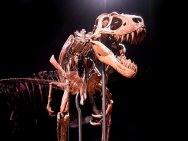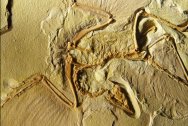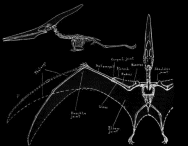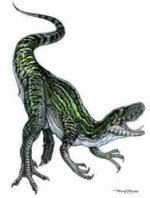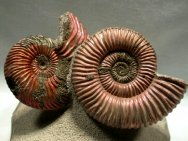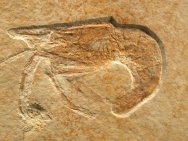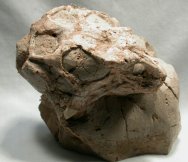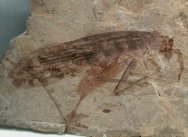Mesozoic Era Paleobiology
Paleobiology of the Mesozoic EraThe Age of Reptiles |
Back
to Paleozoic Era Paleobiology | |||
|
The fossil record supports a theory of plate tectonics now widely accepted. At the start of the Mesozoic, nearly all of Earth's land is believed to have been united in a single supercontinent called Pangaea. Over the Mesozoic Era, Pangaea split into a northernmost continent Laurasia and a southernmost continent Gondwana. Laurasia then divided into North America and Eurasia, while Gondwana eventually separated into the four modern-day continents of South America, Africa, Australia and Antarctica. The Triassic’s climate was probably hot and humid, and thus particularly suitable for reptiles. For 140 million years prior to the Cenozoic Era, dinosaurs held dominion over the land, as their stage was prepared by the great extinction at the end of the Permian Period. The cause and timing of dinosaur ascent have been broadly debated, but evidence is accumulating that a bolide strike rendered the earth only survivable by the hardiest of terrestrial animals, the dinosaurs. The
Permian-Triassic (P/T) Extinction Event marked the end of the
Permian Period of the Paleozoic Era, and the start of the Triassic
Period of the Mesozoic Era. The P/T extinction decimated the brachiopods,
corals, echinoderms, mollusks, and other invertebrates. The last
surviving trilobite Order, the Proetids, also did not survive.
The P/T Among the enchinodermata, the inadunate crinoids, which had barely survived the end-Permian extinction with one family, finally disappeared. While crinoids were the most abundant group of echinoderms from the early Ordovician to the late Paleozoic, they nearly went extinct during the Permian-Triassic extinction. All the post-Paleozoic crinoids, namely the Articulata, are presumed to be a monophyletic clade that originated from the inadunate Order Cladida. However there seems to be a great gap between the morphologies of articulates and Paleozoic crinoids. Thus, a single genus of crinoid is known from the early Triassic, and is ancestral to all "deep water" extant articulate crinoids.
The Archosauromorph reptiles, and most notably the archosaurs, diapsid reptiles that first appeared during the late Permian, inexorably displaced the synapsids that had dominated the land during the Permian. The plant-eating dinosaurs that appeared during the mid-to-late Triassic were the first ornithischians, or bird-hipped dinosaurs, and were not larger than turkeys. The early dinosaurs got bigger, faster and more ferocious, and preyed on and eventually eliminated many of the larger reptiles so that only the smallest survived. The first flying vertebrates, the pterosaurs appeared in the Triassic. The most primitive mammals probably appeared in the late Triassic, descending from a mammal-like suborder of theraspid reptiles known as cynodonts. The Triassic period closed with an extinction event that particularly affected marine life, including decimation of marine reptiles, except the surviving ichthyosaurs and plesiosaurs. A quarter of invertebrate families met extinction, as well as the conodonts. Actually, many extinction events punctuated the Triassic, which are believed to have provided additional selective pressures fostering the dinosaur radiation into emptied niches. Triassic land was predominately the supercontinent Pangea (meaning all the land) located near the equator. Sediments from the Triassic in the deeper ocean have been mainly subsumed by subduction of oceanic plates, leaving but a sparse marine fossil record. Dinosaurs would thus go on to be increasingly diverse and dominating in the subsequent Jurassic and Cretaceous Periods. The stereospondyl labyrithodont amphibians, a group that had been successful through the Triassic, suddenly and dramatically disappeared. Among other tetrapods, several reptilian orders also became extinct, including the protosaurs, nothosaurs, and placodonts. Jurassic
Period
(208 to 146 mya) - dinosaurs rule the land
(Jurassic Fossils) The immense plant-eating dinosaurs (the sauropods) were ubiquitous and were the prey of the large theropods, including Ceratosaurs, Megalosaurs, and Allosaurs. Among plantae, Gymnosperms (especially conifers, Bennettitales and cycads) and ferns are common providing abundant food for the sauropods. Birds evolved during the late Jurassic. The pterosaurs, the flying reptiles, were common in the Jurassic. Fish and reptiles dominated marine environs. The ichthyosaurs, plesiosaurs, and marine crocodiles flourished, as did bivalves, belemnites, brachiopods, echinoids, starfish, sponges and ammonites among the invertebrates. As a general rule, the mammals remained diminutive and backstage during the Jurassic. Cretaceous Period (146 to 65 mya) - (Cretaceous Fossils)
The
archosaurian reptiles, particularly the dinosaurs, continue to
dominate the land. Climate changes due to the breakup of Pangaea
allowed flowers and grasses to appear for the first time. The
most well known dinosaurs, Tyrannosaurus rex, Triceratops, Velociraptor
and Spinosaurus all lived in the Cretaceous. Pterosaurs remain
common until the Upper Cretaceous when competition occurs from
evolving birds. Mammals persist in their backstage existence among
life on land. The Cretaceous ended at the so-called KT boundary, or the Cretaceous-Tertiary (K-T or KT) extinction event, that occurred some 65.5 million years ago. While the duration of this extinction remains unknown, half of all life’s genera disappeared; most famous was the extinction of the non-avian dinosaurs. Though many theories exist for the cause, the most widely-accepted is an impact on the Earth of an immense body from space.
|
||||
|
Fossil
Museum Navigation:
Home Geological Time Paleobiology Geological History Tree of Life Fossil Sites Fossils Evolution Fossil Record Museum Fossils | ||||||

